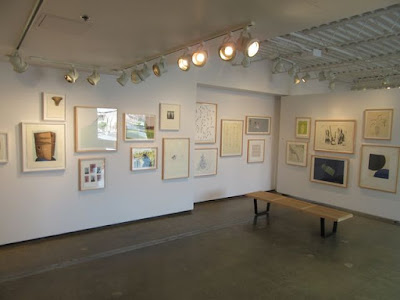DRAWING
Tinting Red before cutting:
Pavel rubs thin light red acrylic paint
over the grey linoleum 9 x 12 surfaces,
so that the cut areas will show up as light grey,
making the final "white" areas easy to see and grasp
making the final "white" areas easy to see and grasp
Transferring image with graphite paper
Drawing the image onto the linoleum,
with graphite paper below the original drawing/photo,
and a transparent sheet on top of the original drawing/photo
Drawing with a Sharpie
directly onto the linoleum
Drawing the white areas with a blue pencil,
to be definitely cut out with the knives
One could even draw the white areas with a
CUTTING
Pavel brought a variety of cutting tools,
including the long handled Japanese set in the middle --
Power Grip --
which were a favorite
There were various sets of
Karsten Creightney brought his own
wood cutting tools
These tools were custom made
by Fernando Solando
in Coatepec, Veracruz, Mexico,
from hand files
Mary used a "rake" to make greys,
with a band of parallel fine cut lines (uppper right)
Pavel inked Krrrl's drawing in black,
to make the cuts more visible
Afterwards, Krrrl realized
that he had a long ways to go
to salvage this linoleum sheet
Missing Step -- The linoleum image has to be transferred to an acrylic sheet first, before the color step. We mostly used a Print Frog. See Pavel's example sequence for this step.
INKING and PRINTING
acrylic monoprint sheet
All kinds of colors of Akua Intaglio inks,
and all sizes of rollers!
The ink has to be rolled onto the acrylic plate
Ink can be taken off with a Q-Tip,
to clean up edges, or to bring out highlights
Transparent acrylic plate with ink
PRINTING
Monoprint First -- using good paper, to make a monoprint with the colored acrylic sheet.
Running through the press
the first time
with good paper
First image is the monoprint
from the inked acrylic sheet
Key Color Second -- The linoleum carved block is printed in black, on top of the color monnoprints, made with the acrylic sheets.
5 passes in black
over the linoleum block
The inked linoleum sheet
should have a shine all over.
Make sure to ink the corners,
and wipe the ink that gets on the thin edge of the plate
Running the paper through the press
the second time
to put the black key image
over the red color monoprint
Inspecting the final masterpiece
"Leopoldos" -- Mary used a fine "rake" tool to scratch fine parallel lines into the linoleum sheet. Pavel called those lines "Leopoldos" after we saw the same technique used by Leopoldo Mendez, the master relief printmakers of Mexico.
The fine, shallow "rake" lines
came out on Mary's final print,
by using a hard roller,
and adding magnesium carbonate to the ink
to make the ink stiffer
Print by Mexican master Leopoldo Mendez --
Note the parallel lines made with a "rake"
CLEAN UP
- The Akua inks clean up with water, and also alcohol.
- Rumor is that Kirtland Soy Sauce (from Costco) cleans up oil ink really well, including cleaning brayers (tip from Self-Help Graphics).
- Coca Cola is also rumored to clean up oil based ink, though it does not do a good job cleaning up dried oil based ink.
Pavel tries cleaning his linoleum plate up
with Coca Cola,
but it doesn't get the drier ink off
Back to the start -- "Relief + Color Weekend Workshop by Pavel Acevedo"
AFTERWARDS
Pavel visited Tamarind Institute
on April 24th
Pavel also visited Takach Press,
and got a tour of the press making facility
Pavel's print, taken from Instagram,
and laser cut into MDF
at Quelab hackerspace in Albuquerque
(and also on a small acrylic sheet)
Pavel later took those small laser cuts back with him to California, and make small relief prints from them, using a soft roller on the plastic laser cut plate:
Original linocut print,
vs the smaller bootleg print,
made from an acrylic laser cut
taken from this Instagram photo
The original
and baby prints








































Great, thorough description of the whole workshop! THANKS
ReplyDelete